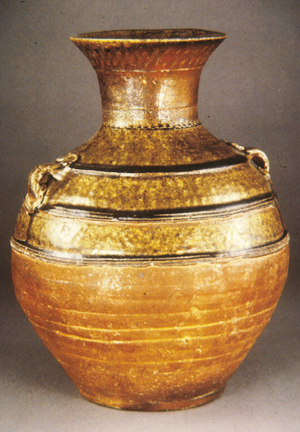
HAN DYNASTY ASH GLAZED JAR , STONEWARE,
China, 100 BCE - 100 CE, 13.5" height
ART 198 - HISTORY OF WORLD CERAMICS
| During the Han Dynasty, potters learned how to build increasingly efficient kilns. The tunnel kiln was developed which was capable of reaching the higher temperatures necessary to fire stoneware clays (generally considered to be above 2000° F). This higher firing temperature results in a greater fusion of the clay body, a process called vitrification (literally, to become a glass). Stoneware clays are typically gray to brown in color, and have a greater 'hardness' than earthenware, and moreover, are not porous after firing, meaning stoneware vessels do not leak. At this higher temperature other interesting effects occur. For example, the wood ash that is an inevitable by-product of the wood firing process at high temperatures such as this interact with the surfaces of the clay objects in the kiln. The ash acts as a flux, lowering the melting temperature of the clay surface slightly, and producing a 'self glazing' effect in the kiln. Colors produced are very 'natural' and recall the colors of many minerals, which of course were produced in nature under similar heated conditions (volcanic or igneous rock). Ash glazes were difficult to control, since some areas of a pot would get a higher deposit of ash than others, resulting in too much glaze in one place (running) and not enough in another (too dry a surface). Potters quickly learned how to control this process, however, and soon they were adding the ash directly to the clay body to produce a glaze slip they could apply to the surfaces of the ware before firing. This is the method by which this jar was glazed. The upper half of this piece was painted with a glaze slip made of clay and ash prior to firing. During the firing, the ash would melt the slip into a glaze on the surface. They dealt with the tendency of this glaze to run by confining it within the raised borders of this jar. Note how the glaze has run down to collect at the upper edges of these raised lines. These lines served as 'dams' to hold back the running glaze. Production of vitreous, glazed stoneware meant a much more hygienic way of storing foods, since these glazes are completely food safe and the clay body was non porous, not to mention the increased hardness and durability of the vessels. | HAN DYNASTY ASH GLAZED JAR , STONEWARE, China, 100 BCE - 100 CE, 13.5" height |
|
|